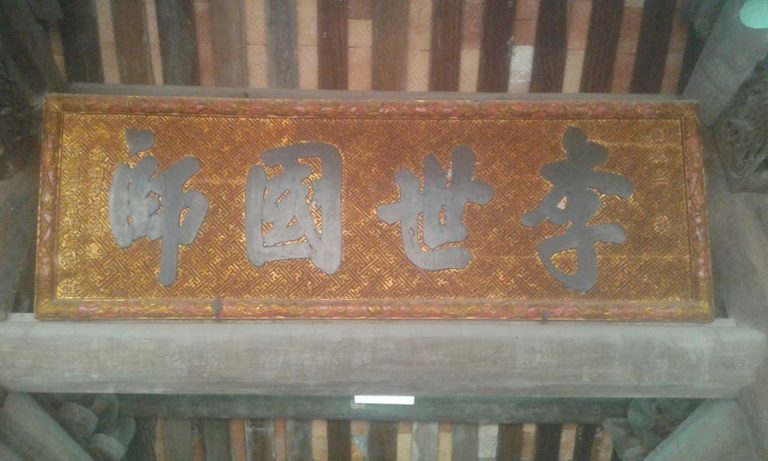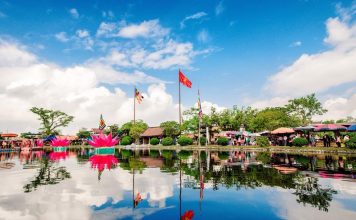Keo Pagoda—a national special relic and an emblem of Thái Bình’s rice homeland—has long been a sacred destination for pilgrims seeking to connect with history and appreciate the cultural heritage left by their ancestors.
Each year, Keo Pagoda hosts two grand festivals: the Spring Festival on the 4th day of the Lunar New Year, and the Autumn Festival, held from the 10th to the 15th day of the ninth lunar month, to commemorate the centenary and birth anniversary of Zen Master Dương Không Lộ. In 2017, the Keo Pagoda Festival was officially recognized as a National Intangible Cultural Heritage.
With its unique 17th-century Post-Lê Dynasty architecture, Keo Pagoda is particularly renowned for its bell tower, resembling a lotus bud reaching skyward. Moreover, its Hán-Nôm epigraphy, including stele inscriptions, name plaques, horizontal boards, couplets, Buddhist scriptures, imperial edicts, woodblock prints, and handwritten sutras, has drawn the attention of researchers and visitors alike. These historical texts serve as invaluable literary and historical records, offering future generations insights into Vietnam’s rich past.
One of the most remarkable artifacts housed within Gác Roi Pavilion—aligned along the pagoda’s sacred axis—is a horizontal board bearing the four large Chinese characters “Lý Thế Quốc Sư” (National Preceptor of the Lý Dynasty), inscribed with the date Khải Định Year Three (1918). The calligraphy was originally composed by the renowned scholar Nguyễn Hữu Cương, while the funding for the board was contributed by the people of Keo Village, Thái Bình, and Hành Thiện Village, Nam Định.
Nguyễn Hữu Cương (1855–1912), a native of Động Trung Village, Vũ Trung Commune, Kiến Xương District, Thái Bình Province, was the eldest son of Nguyễn Mậu Kiến. In his youth, alongside his father and brother Nguyễn Hữu Bản, he participated in land reclamation efforts in Tiền Hải under the leadership of Doãn Khuê plantation. A scholar proficient in both literature and martial arts, he established a printing house to disseminate patriotic works opposing French colonial rule. Following the French occupation of Hà Nội in 1882, he joined forces with his younger brother and General Lê Văn Điếm and Judge Hồ Bá Ôn to defend Nam Định. In July 1885, after Emperor Hàm Nghi — a former student of Nguyễn Doãn Cử from Keo Village — issued the Cần Vương Edict, Nguyễn Hữu Cương rallied local youths to resist French rule. However, after years of surveillance, he was arrested in late 1908 and exiled to Cần Thơ Prison, where he passed away on May 12, 1912. His literary legacy includes the poetry collection “Mai Hồ thi cảo” and the illustrated work “Mặc Hý”.
According to elders of Keo Village, on the 4th day of the Lunar New Year in 1876 (Year of the Rat, reign of Emperor Tự Đức), Nguyễn Hữu Cương, then aged 22, attended the Keo Pagoda Spring Festival, where his literary and martial prowess had already earned widespread acclaim. At the festival, local dignitaries, including scholars Nguyễn Doãn Trung, Nguyễn Doãn Tựu, and Nguyễn Tất Biểu, requested a calligraphic inscription from him to enshrine in the pagoda.
As he had not brought his writing tools, Nguyễn Hữu Cương improvised a remarkable method. He requested a large sheet of traditional dó paper and had villagers spread a thin layer of rice across its surface. Using bundled betel palm leaves as a brush, he masterfully “wrote” by sweeping away the rice grains, revealing the blank paper underneath. The sheer force and precision of his strokes, characteristic of a martial artist, created a striking calligraphic imprint. Once the characters were outlined, he retraced them with a fine brush to finalize the inscription.
This inscription remained uncarved for 42 years, until 1918, when the villagers commissioned master woodcarver Nguyễn Hữu Cần from Hành Thiện, Nam Định, to craft the gold-gilded wooden horizontal board. Despite the hardships of the era, the collaboration of artisans and benefactors from various villages ultimately brought this extraordinary work to fruition—a testament to the enduring spirit of Vietnamese cultural heritage.
!["[KTMH] Trailer | WHAT TO DO TO MAKE SUMMER HOLIDAYS MORE MEANINGFUL?"](https://i3.ytimg.com/vi/s0VUGa1v6uw/maxresdefault.jpg)

.jpg)

.jpg)